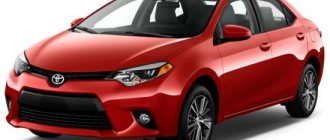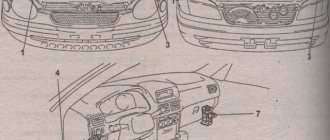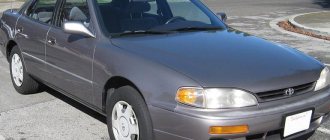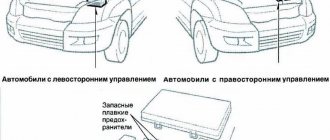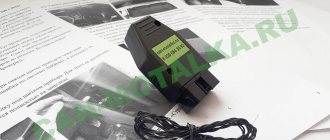A sports car in a mid-class sedan body, built on the same base as the Corona. This is a legend of its time - Toyota Carina E. The body shape is optimally suited to overcome air currents. And quite powerful gasoline engines of 1.5 and 2 liters, as well as a 2.2 liter turbocharged diesel engine, allow you to reach high speeds. In 1998, the first configurations with a six-speed manual transmission appeared. And some cars even had all-wheel drive.
History of Toyota Carina E
Toyota Carina was produced for 31 years - from 1970 to 2001. The first generation was intended for export to Europe and the USA. But due to US restrictions on the import of cars, sales of the model fell sharply. The car was equipped with a 1.6 liter petrol engine.
Production of the second generation began in 1977. Most cars had 1.6 liter engines, but there were some with 1.8 and 2 liter engines. An automatic transmission was optionally installed. And most importantly, the model was presented in three body types: station wagon, sedan and coupe.
In 1981, the third generation Carina debuted, which in the Japanese domestic market was called Toyota Carina Surf. As with previous modifications, the engine was located at the front and the drive was rear-wheel drive.
But it was during this period that most competitors were already switching to producing cars with front-wheel drive. To the previously used engines, a 1.8-liter turbodiesel (power 123 hp) was added, as well as a turbocharged gasoline engine of the same volume (198 hp).
The production of the fourth generation Toyota Carina E began in 1984. It was at this time that the Karina sedan received front-wheel drive. Coupes and station wagons were still rear-wheel drive. In 1985, production of the Toyota Carina II hatchback began, equipped with a 1.8-liter gasoline engine. The car had front-wheel drive.
The fifth generation appeared in 1988. The range of engines still included diesel and gasoline engines of various sizes. An all-wheel drive version of the sedan also appeared at this time. The Toyota Carina II was produced for European markets, which was an exact copy of the 8th generation Crown.
The sixth generation was produced in the period 1992-1996. At the same time, the Toyota Carina E appeared, which replaced the Toyota Carina II. Original design and attractive appearance – it looks good even a quarter of a century later. Model E was intended for sale in European countries. Due to the fact that the car has excellent corrosion protection, it is loved by motorists.
The interior trim is inexpensive, but high quality and pleasant. There is plenty of space - even in the second row of seats, passengers of any height feel comfortable. Smooth ride, excellent handling, you can enjoy the speed - this model probably inherited this from its sports ancestors.
And the last, seventh generation, was produced in the period 1996-2001. The line of engines included petrol engines of 1.5 l, 1.6 l, 1.8 l, 2 l. The choice of diesel engines is small - only one with a volume of 2.2 liters.
Cars with two-liter engines had all-wheel drive.
In 1998, the first restyling took place. The second wave of changes took place in 2001. But then the model was discontinued and replaced by the Toyota Allion.
Toyota Carina 92-96 operation, maintenance and repair manual
Alternator TEST 1. DIODE CAUTION: Never use a megaohm tester (designed to measure high voltages) or similar equipment to perform this test. Otherwise, the diodes may be damaged. 1) Positive diode check Check the continuity between the diode terminal and the positive side of the heat sink. The positive diode's normal resistance is 1 ohm or less only in the direction from the diode's terminal to the heatsink. 2) Check the negative diode Check the continuity between the negative side heatsink and the diode terminal. The negative diode's normal resistance is 1 ohm or less only in the direction from the heat sink to the diode terminal.
2. ROTOR 1) Slip ring surface Check the slip rings for dirt or any unevenness on the contact surface. Resurface the ring using a lathe or sandpaper. 2) Outer diameter of the slip ring Measure the outer diameter of the slip ring. If the slip ring is worn, replace the rotor assembly. Slip Ring Outer Diameter: Standard 22.7 mm (0.894 in.) Limit 22.1 mm (0.870 in.) 3) Continuity Check Check the resistance between the slip rings using a continuity tester. If the resistance is outside the standard value, replace the rotor assembly. Nominal resistance: Approximately 1.6 - 1.9 ohms 4) Insulation check Check the continuity between the slip ring and the rotor core or shaft. If the resistance is 1 ohm or less, replace the rotor assembly because the rotor coil is shorted to ground. 5) Ball bearing (rear side) Check the rear ball bearing. Replace if noise is heard or if the rotor does not rotate smoothly.
3. STATOR 1) Continuity Check Check for continuity between each end of the stator coil winding wire. If the resistance is 1 MΩ or more, the wire is damaged. In this case, replace the stator assembly. 2) Insulation check Check for continuity between the stator core and each end of the stator coil winding wire. If the resistance is 1 ohm or less, replace the stator assembly because the stator coil is shorted to ground.
4. BRUSH 1) Measure the length of each brush. If wear exceeds the specified limit, replace the brush. Each brush is marked with a regulatory limit mark. Brush Length: Standard 18.5 mm (0.728 in.) Standard Limit 5.0 mm (0.197 in.) 2) Check brush spring pressure. Using the spring pressure indicator, press the brush into the brush holder until the tip protrudes 2 mm (0.08 in). Then measure the brush spring pressure. If the pressure is less than 2.2 N (224 g, 7.91 oz), replace the brush spring with a new one. The new spring pressure should be 4.8 - 6.0 N (489 - 612 g, 17.26 - 21.58 oz). 5. BEARING (FRONT) Check the front ball bearing. If there is resistance when rotating or an unusual noise is heard, replace the ball bearing.
Features of Toyota Carina E
Toyota Karina E was produced for the European market, so it can be found more often than others on the roads of the Russian Federation and the CIS. The main difference is the location of the steering wheel. The model had several engines, but only two transmissions - a five-speed manual and a four-speed automatic. The reliability of both gearboxes is high; over the years of operation they have shown their best side.
The car has a double-wishbone transverse suspension. But the problem is that the designers did not take a completely standard approach to the design and production of this unit. Therefore, difficulties may arise during repairs. True, repairs are rarely needed - the reliability of the suspension is quite high.
Introduction The Carina E replaced the Carina II in 1992 and was produced until 1998, after which Toyota decided to drop the Carina name for the next generation of cars in Europe and began producing the Avensis, thereby emphasizing that the Avensis became a completely different car. Although if you put Karina and Avensis side by side, you can discern a lot of common lines, and the majority of the engines have successfully migrated from Karina to Avensis. Like Avensis, the name Karina E was printed on nameplates exclusively for the European market. The family of models itself is called Corona and its history begins in 1957. History of the model The first car with the name Crown was released a little later - in 1958 (and now the 11th generation of the model is rolling off the assembly line). True, it had nothing in common with the current Crown - a length of just over four meters, a longitudinally mounted 4-cylinder engine, rear-wheel drive, and with its rounded, smooth shape the car was vaguely reminiscent of our Moskvich-407. For the next two decades, Toyota remained true to itself in the Crown model, without changing the “classics” to front-wheel drive and a transverse arrangement of the power unit. Only the body design and interior design changed. Soft lines remained in the 60s. They were replaced by deliberately chopped edges, which became fashionable in Europe and America. But the interior, on the contrary, does not need rudeness, so Toyota designers sought to achieve greater and greater comfort, stuffing it with various “bells and whistles” (at that time even headrests were considered such), allowing it to not be inferior to competitors. Moreover, the Crown, with better equipment, cost a little less than classmates from other companies. This circumstance allowed her to outstrip them in terms of sales. Engines also changed somewhat in technical terms as generations changed. This mainly concerned increasing the working volume. For example, in the early 70s, the Crown received a 1.8-liter engine, and a little later a two-liter power unit. By the way, both of them were also equipped with an automatic transmission. Over time, the successful and reliable, but already outdated design ceased to satisfy customers. After all, by the beginning of the 80s, the classic layout on cars of this class had already turned into an anachronism. Therefore, by 1983, Toyota had prepared a completely new front-wheel drive model under the concern’s traditional name Corona FF (factory classification T15-type), while it was supplied to Europe under the Carina II brand. Cars intended for different markets differed from each other only in small body parts and the location of the steering column. The family was represented by two body types: a four-door sedan and a five-door hatchback. Both had folding rear seats, which made it possible to significantly increase the usable volume of the luggage compartment. In addition, the trunk lid was lowered almost to the bumper, thereby reducing the loading height. True, the sedan's opening was limited by the rear lights. The equipment of the Japanese and European versions, in contrast to the appearance, varied much more. The “European” received an extremely poor configuration without electric windows, electric mirror drives, and the only comfort equipment available was a height-adjustable steering column and a radio tape recorder. But the Japanese model was stuffed to the fullest. As standard, it had electric windows and mirrors, an air conditioning system and a radio with programming capabilities, and the most prestigious copies were equipped with a liquid crystal dashboard. Under the hood of the Corona FF/Carina II, in-line four-cylinder carburetor or injection engines with a displacement of 1.5 were located transversely; 1.6; 1.8 and 2.0 liters with power from 83 to 140 hp. With. (the latter was equipped with a 16-valve cylinder head). In addition to gasoline engines, there was also a 2-liter diesel engine with a capacity of 72 hp. With. Power plants were coupled with 4- or 5-speed manual or 3- or 4-band automatic transmissions. The rear dependent suspension, consisting of a continuous solid beam, was replaced by an independent McPherson strut system. At the beginning of 1988, the next generation Corona FF/Carina II (T17-type series) debuted. The cars received a new, more attractive body with softened edges. The range of models was continued by a five-door station wagon called Toyota Carina Surf. Inside, as well as outside, cars have become much more elegant - both in appearance and to the touch. The lines of the front panel have noticeably rounded, and the console has turned somewhat towards the driver. In accordance with traditions, the European version of Carina II received very poor equipment as standard. For example, electric windows were installed only at an additional cost, and not a small one at that. But the Corona FF, offered on the domestic Japanese market, had a much more expensive package. In addition, the backrests of the rear seats folded in a ratio of 60:40 on all types of bodies, which increased the already rather large trunk (for the sedan its volume was 440 liters, for the hatchback - 444 liters). Description of the model Karina E was produced mostly in Japan until 1994, after which the production of cars of this brand was finally transferred to the English Burnstone, which can be found out by the car body number (gb - British, jt - Japanese). European manufacturers began to supply components to the English conveyor, which entailed some changes in the design of the car, so spare parts for “Japanese” and “English” models are not interchangeable, which should be taken into account when ordering them. In addition, the transfer of production to the UK also affected quality. No, the Toyota Carina E still remains one of the most reliable cars, but discerning connoisseurs of the “fine arts” place Japanese-made cars higher. The car came in three body styles: sedan, hatchback (liftback) and station wagon. There were, in principle, only two configuration options: a simple XLI version with unpainted bumpers, manual windows, up to 1995 and without air conditioning, etc. and the less common GLI, which is very well equipped. In 1996, Karina underwent a slight facelift, which consisted of changing the radiator grille, moving the Toyota badge to the hood and changing the color scheme of the rear lights from white-red to white-yellow-red, making them similar to the lights of the Passat B4. In this form, the model survived until 1998 and was replaced by the “smiling” Avensis. Engines. The range of engines installed on the Karina E is quite large: 4A-FE (1.6 l) - available in three versions: With a catalyst, without a catalyst and with a system for changing the geometry of the intake manifold (Lean Burn), the engine power was 99 hp. and 107 hp, and the Lean Burn system did not reduce engine power. More detailed information about the operation of the system can be found here: Lean Burn 7A-FE (1.8 l) - the engine began to be produced in 1996, the power is the same 107 hp. This engine model successfully migrated to Avensis after Karin was discontinued from production. 3S-FE (2.0 l) - the most reliable and unpretentious of the entire range of engines, while producing 133 hp, one of the disadvantages of the engine can only be noted increased noise during acceleration (although I personally like it), this is due to the presence of gears in the mechanism gas distribution, with the help of which the intake camshaft is driven. In this regard, the load on the timing belt increases, which requires more careful monitoring of the degree of wear and frequency of timing belt replacement. Of all the reviews about the engine that I was able to find on the Internet, nowhere was it explicitly written about the meeting of the valves with the pistons in the event of a broken belt, but it is better to make a planned replacement than to rely on luck. 3S-GE (2.0 l) - a pumped-up sports engine with an output of 150, or even 175 hp, according to various sources. The engine is made with good torque at low and medium speeds, so a car with such an engine accelerates equally well at any speed. And at the same time it handles superbly, giving the driver real driving pleasure. The price to pay for this was a completely changed suspension design. In front, instead of McPherson struts, there are double wishbones. The shock absorbers are replaced along with the wheel axle, which is very expensive. The rear suspension is also different from the usual one, so with spare parts for the charged version there are questions both in terms of delivery time and money, since everything costs several times more than the standard versions. It was produced from 92 to 94 so it will be very difficult to find it, but there are no impossible tasks. 2C (2.0 l) diesel - considered one of the best diesel engines among passenger cars, develops a power of 73 hp. 2C-T (2.0 l) diesel - a turbocharged version of the previous engine, began production in 1996, power is 83 hp. The fame of very reliable and unpretentious power units played a funny joke on them. The same Germans who won’t spend an extra penny, knowing that it’s not so easy to kill Toyota engines, saved on oil changes, almost doubling the service intervals. They had enough mileage for one hundred and fifty thousand, and at least grass wouldn’t grow there, so when buying a used car, you need to be extremely careful. A positive feature of all Toyota engines is the absence of hydraulic valve lash compensators. There is nothing surprising in this; adjusting the gaps on these motors is relatively simple, and it is required very rarely. But no headaches with hydraulic compensators, no wasteful operations to purchase and replace them. The only thing is the cost of the shims for adjustment. Here's a quote from LoneWolfa: “No one at the service station has washers - you still have to go 2 times: the first time - measure the gaps, count the sizes of the washers. The second time - this time with washers, change them. There are washers to order in Zhdany (maybe in Malin too, I don’t know) - 6 killed raccoons apiece.” On my own behalf, I’ll add that there are 4.5-5. I’ll add one more thing: everything is very simple to adjust; the whole operation took me about 2 hours. For adjustment, 16 pcs of washers were used from the engine and I removed another 16 pcs from the engine lying around for spare parts. This was enough to adjust all the gaps by rearranging and selecting. Lonewolf Disadvantages. Now what is said about Karina’s sores: Many reviews write about the model’s inexpressive appearance and the boring panel, I won’t argue, but I think that this is not so. This is not a business class sedan and everything necessary for a class D family car is present in it for its time. A problem that, in general, has not been resolved during the entire production period, is contamination of the lower steering cardan, which is caused by the absence of any protective casing on it. The result is a biting of the steering wheel, which feels as if the power steering is turned off in certain positions. There is no need to panic, with such a driveshaft, before replacing it, I drove it for about a year, during which time I only sprayed WD-40 on it three times. Because of the cardan shaft, play also appears in the steering wheel, which many careless mechanics diagnose as a broken rack (imagine the cost of replacement :0). The replacement procedure is described in detail in the Toyota conference on auto.ru. Some craftsmen in Russia press in the driveshaft from the steering wheel of a VAZ 2105 and install a cover from the OKI, I agree about the cover, but about the driveshaft from the five - excuse me, $65-70 is not the right amount to save. One of the diseases is the failure of the driver's electric window (cable breakage) due to more frequent opening; mine crashed after trying to open the window in the cold with a cold interior. The glass does not fall, as in the Opel Omega, thereby blocking the door opening drive, but remains in the position where you move it with your hands. Therefore, I quietly traveled for 2 weeks until the original arrived from Moscow. Original because it's being disassembled used. the system costs $50 with a motor, and on exist.ru it costs $48 new without a motor, and the motor was in excellent condition. In general, the lack of proper protection of the engine compartment is the reason for dust and dirt getting under the hood; also last winter, due to snow, the power steering belt was torn; upon closer inspection, it was revealed that small stones from under the wheels eat into the belt from the inside and cause its cliff. The same situation applies to the alternator belt. Belts cost accordingly: $6 and $10 Well, more than that, as they say: “Well, what else breaks in Toyotas….. ahhh the light bulb burned out!!!!” Those. Karina is a fairly reliable car, provided that you do not spare money on its ongoing maintenance. Operating experience. I bought my Karina here, from friends, at a ridiculous price (3200 in 2003), but with a bunch of problems, from the point of view of the previous owner. So Model: CARINA E (JPP)SED/LB Equipment: ST191L-ALMNKW Color: 742 (dark green pearl) Engine: 2000CC 16-VALVE DOHC EFI (3SFE) Issue date: 6/92 Features: steering wheel, servo, electric glass, electric heated mirrors, electric. sunroof, adjustable headlights, abs, fog lights, immobilizer, towbar. Problems: Biting the steering wheel (cardan), broken suspension, almost bald tires on the front, stoned hood, broken and poorly made left rear fender, scratch on the right side (someone tried to use a nail), rumbling in the engine, mileage 217,000 km and not The driver's door lock worked (i.e. only from the inside). The advantages were, of course, the price, radio with CD, tinted side windows. The problem with the driver's lock was immediately solved by removing, disassembling, removing the cracked plate (or whatever it was) and removing the tinting from the front windows, because... Chinese film and nothing is visible. The timing belt will be tightened, the oil, oil and air filters, CV joint boot and rear stabilizer struts will be replaced. Within six months, the front brake pads, rear trailing arms (used, they are very expensive new, but only come assembled) and rear shock absorbers. Because of a freak on a GAZ-53 (Lelchitsy urban settlement), which tried to turn from the second lane into the yard near GUM, the left front fender had to be changed, although the insurance was still enough to paint the hood. By the summer of 2004 and for the planned trip to the south, Michelin summer tires were purchased, mudguards were installed, the rear window was 95% tinted, the sunroof and stripe on the windshield were tinted with a normal American one, an alarm system and a new battery were installed, the timing belt with rollers was changed, the fuel filter was changed, and the suspension was brought to life. For 2500 km, I never looked under the hood. By the winter of 2004/2005, I finally changed the driveshaft, rear brake pads, front winter tires and the broken window regulator. In total, the car has driven 35,000 km in almost 2 years; in all that time the car has never failed on the road, it always started with half a turn. The engine worked like a clock. Operating costs (excluding the cost of work, for certain reasons they are still free) without gasoline, car washes, stinkers, fire extinguishers, etc. amounted to: Oil 3 changes = 53 Oil filters. = 11 Air filter = 6 Fuel filter = 10 Timing belt = 16 Rollers = 29 Alternator belt = 10 Belt g.u. = 6 Lane pads = 28 Rear pads = 18 Stub racks 4 pcs = 45 Stub bushings 4 pcs = 19 Rear levers. 2 pcs = 50 Silents front 2 pcs = 15 Ammo rear 2 pcs = 140 CV boot = 14 Driveshaft = 60 Window lifter = 48 Battery = 30 Different light bulbs = 1 Total $618 I had a 10-20% discount on some items, so the prices are a little lower. Here you can add expenses: Repairs for insurance = 220 Alarm = 65 Tinting = 60 Winter/summer tires in a pair = 300 Toyota badge 2 times = 10 (pioneers should be shot for this) Conclusion. You quickly get used to good things, and after driving a Toyota car you think that the next one will also be a Toyota, you also understand that you want something more, so in the near future you will have to part with your Karinka, I hope the next car will be Picnic, with the same dimensions as Karina and with the same 3S-FE engine. By the way, Karina is taken by a relative at quite a market price, one might say that I even went up :). Toyota Club BY
Exterior and interior of Toyota Carina E
Upon a thorough study of the body of the Toyota Carina E, you can see one feature - there is practically no rust. Yes, there are examples that were repainted several times during their entire service life.
But still, the base layer holds up excellently, and rust, bubbles and chips are unlikely to appear. Anti-corrosion protection of seams is also at a high level. Of course, you can “kill” any body, regardless of treatment. But if you take care of the car, there will be no problems with the hardware.
The salon is stylish, laconic, there is nothing superfluous in it. The entire design is designed in the same style. Roomy car, comfortable, convenient steering wheel position and high-quality seats. There is only one minus in the cabin - it is outdated. But this does not in any way affect the convenience and comfort.
Read: Toyota GR Supra compact sports car
All owner reviews about Toyota Carina T170
Those who are only interested in general impressions and dry data on servicing the Carina II can safely skip the next paragraph.
So a year ago I moved to my “swallow”, before that I suffered for quite a long time with the Taz 2108 and Taz 21051, I also had some experience driving my father’s Mazda 626 and Mitsubishi Galant4. So, exactly a year ago my patience came to an end and I said “Enough is enough!” I firmly decided to sell my basin and buy a foreign car as quickly as possible. After browsing through a bunch of websites on automotive topics and reading a bunch of reviews, I decided to take a Volvo, and the 850 is a must, because... only on it and on the 440th front-wheel drive. I must say that at that time my money was small, about 5 thousand. American rubles. Over the next weekend, I looked through all the offers in the advertisements, nothing worthwhile, or very expensive, or completely killed. And I needed a car urgently, because I was like in that movie: “without wheels, like an orphan, only on foot.” Out of grief, I had to go to the local so-called “Car Market” with an increasingly fading hope of buying a good car. For my money, only the same degenerates of the domestic automobile industry were found there, and from foreigners only a Saab 9000 with a dead engine, a Volvo 440 painted with a brush, a Vekra rotten through and through with a fur coat almost reaching the windows, and a Toyota Karina2 which stood in the farthest corner, covered in dust, with a price tag of 3000 USD. At first I didn’t even look at the Toyota, I wanted something fresh, more dynamic, but after making a few circles around the market I decided to look at it just for fun. That's where it all started.
The first thing that surprised me about the car was its almost perfectly clean and well-kept interior, the well-thought-out ergonomics of the driver’s workplace, everything is at hand, you get the impression that you’ve been driving this car your whole life. The engine started literally with half a turn and reached the required 1500 thousand. rpm, and after a couple of minutes the car warmed up and the revolutions dropped to 700, while the engine became almost inaudible. An external inspection revealed a small blow to the right front fender and corrosion on the rear arches. All! For 16 years the car has never been painted! There is anti-corrosion coating on the bottom and not a single hole! This really amazed me! Needless to say, both my wife and I really liked the machine, but we decided to wait and look for a “cooler” device, go to St. Petersburg and look there. But my patience was only enough to get to the house, take the money, return back and pay the deposit! Two days later I became the happy owner of a Karina 2 with a 4A-FE, 1600cc engine.
Toyota Carina / Toyota Carina
Carina: parameters, tests (test drive, crash test), reviews, car dealerships, photos, videos, news.
Toyota Carina
- production began in 1996. The combination of style and technology Carina, created by Toyota, has proven itself in the market and is time-tested.
Among the existing basic colors of Carina, you can easily find one that suits you, but most likely you can choose it to order. We most likely do not have all the configurations of this Toyota Carina model, among which there are various Carina assembly options: the gearbox can be automatic or manual, leather trim or wood inserts, wheels and other additional elements of the Carina body, which will certainly be reflected in the price Carina. The technical characteristics are good, but do not forget about the safety of the Carina or the engine size, which will then make itself felt in terms of operating costs in the future, as well as Carina repairs and maintenance with a warranty period. Since the purchase is made not for several months, but for several years, therefore, consider for yourself what you will do in the summer and winter, what trips to make in Carina
. The table below shows a comparison of several configurations of the Carina, among the parameters are reflected: what are the overall dimensions of the Carina, what is the fuel consumption in the city, highway or mixed, engine size, maximum speed and acceleration time to 100 km/h, curb or gross weight of the Carina, wheelbase, front and rear wheel tracks, transmission type (gearbox/gearbox), what kind of drive, tire size, how much power or torque and what price. In addition to all the numbers, you can read reviews of car owners about Carina, watch videos or news, tests (test drive, crash test).
